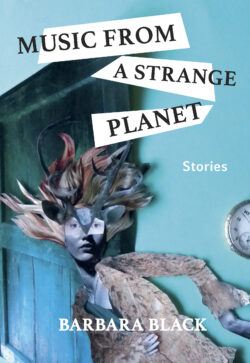1204 Thresholds and transformations
Music from a Strange Planet
by Barbara Black
Halfmoon Bay: Caitlin Press, 2021
$22.95 / 9781773860589
Reviewed by Ginny Ratsoy
*
 Barbara Black’s website informs us that Music from a Strange Planet, her debut short story collection, “began as a series of flash fictions exploring the intersection of human and insect existence” and “metamorphosed” into a larger collection with a broader scope. From a little girl with fly-induced psychic powers to a middle-aged man whose neural short-circuit places him into life as a water strider or a German cockroach, many stories do creatively imagine human-insect intersection; even those that do not often centre on metamorphosis. Yes, we are sometimes in Kafka territory; at other times, the terrain of Atwood or Munro is called to mind. The collection straddles the line between realism and fantasy/surrealism, sometimes within a single story.
Barbara Black’s website informs us that Music from a Strange Planet, her debut short story collection, “began as a series of flash fictions exploring the intersection of human and insect existence” and “metamorphosed” into a larger collection with a broader scope. From a little girl with fly-induced psychic powers to a middle-aged man whose neural short-circuit places him into life as a water strider or a German cockroach, many stories do creatively imagine human-insect intersection; even those that do not often centre on metamorphosis. Yes, we are sometimes in Kafka territory; at other times, the terrain of Atwood or Munro is called to mind. The collection straddles the line between realism and fantasy/surrealism, sometimes within a single story.
The human-insect intersection spectrum is surprisingly wide, as stories range from the witty to the creepy to the quirky to the touching. In “Mastering Surface Tension” Everyman Bert’s tumble from a roof while attempting to dismantle a hornet’s nest lands him in the (delightfully named) St Francis of Assisi Medical Centre, where his neural short-circuit affords him a rich inner life as an insect with the ability to adopt new insect body parts at will. As time passes, wife Grace finds religion and a new romance, and tells her comatose husband that the family has decided to end his life support. Bert is now fully released into his other life, complete with a new mate. In the eponymous story, Lucky Bee is a synesthetic child with a pet cricket; working in tandem, the pair has extraordinary powers—to prevent suicide, alleviate loneliness, produce ethereal music, etc. The story ends with the demise of the cricket, concurrent with Lucky Bee orchestrating an event that has profound consequences for her parents. A mother in “Darkling Beetle” narrates the story of her daughter who, in grade three, elects to get unflattering glasses that alienate her from her classmates. The mother becomes obsessed with finding a stereotypically feminine Halloween costume for Cora, settling on a sorceress. However, Cora retreats further into herself, revealing she wants be a darkling beetle, not anything human. The two select the fabric together, and the mother, although despondent at how unconventional her daughter is, finishes the costume well. On the magic night, though, she becomes proud of Cora’s individuality; the mother has been transformed by her daughter.

“The Mist-Covered Mountains” has a similar touching effect, with an added fairy-tale quality. The presence of a fly in her ear induces an adopted Toronto child, Pippa, to recall, at some level, an ancestor, retired Scottish plumber Dugald, who was a philanderer in his day. On the day Dugald starts out of his retirement funk on a recipe-a-day project, Pippa and Robin, her mother, arrive in the Highlands, where, attracted by the smell of bannock, Pippa leads Robin to Dugald. As she invites herself in, Pippa is perplexed; what she recalls are events of the generation previous to Dugald’s. When Pippa and Robin return the next day to sample Bonny’s Fruit Slice, the only keepsake she has of her birth mother, a preserved insect, hearkens in Dugald memories of a romp with a bonnie lass. Touring Dugald’s property, Pippa unleashes her impressive knowledge of insects, and Robin reveals that her own mother immigrated to Canada from Scotland at age 21, and Robin knows nothing about her father. On the third night, after Bread and Butter pudding, the females leave Dugald with the amber enrobed insect, and on their fourth and final night, Pippa claims Dugald’s granny’s pipe. From a fly in the ear, familial bonds have formed. Encounters with common insects catalyze uncommon metamorphoses.
But less quotidian species are not forgotten. Some broods of cicadas show themselves only every thirteen or seventeen years, en masse, and Black examines human response to both. In “Magicicada” octogenarian swimmer Jean, anticipating the latest return of the seventeen-year cicadas and remembering previous returns, reflects on her life as the mother of a girl she adopted out and a special needs boy and finally takes steps to reconnect with the former. Cicadas prompt even greater transformation in “Sing Fly Mate Die” when an unlikely sad sack wins a romantic trip and, en route, encounters a thirteen-year cicada emergence and an unexpected romance. Both stories delight with their details of the bizarre visual and auditory beauty of the manifestations.

I found the more sardonic stories in Music from a Strange Planet, many of which offer contemporary satirical commentary, most compelling. “So Sorry for Your Loss” is a witty look at a black widow of sorts: a woman who mirrors the collecting of specific moths in her marriage selection. After pinning up the Acherontia styx, Mme. Styx enlists the services of a psychiatrist, Dr. Mori, who becomes husband #6. As she raises the killing jar to Bombyx mori, she realizes her dual obsessions may be at an end. “The Watcher and the Watched” is a clever mash up of academia, online dating and art: a cynical artist themes her first installation around her boyfriend’s thesis on fireflies, her second on penis photos potential dates send her, and her third on a performance piece in which she dons and then sheds the persona of a caribou – one of Black’s many statements on the precariousness of identity. “Walk on Water,” a look at a privileged societal sector, focuses on an aimless former business analyst with vague sculpting ambitions. Saul, a middle-aged husband and father, also has his eye on an exotic barista who, when he tries to take their casual acquaintanceship too far, undergoes a “reverse metamorphosis” (p. 57) toward frumpiness. Saul’s own quasi-metamorphosis begins when the story ends and his wife begins removing a plaster cast from his body. This story, like so many in the collection, manages to be at once biting and tender. More unsettling is “Strangely Luminescent in the Dusk.” Reminiscent of Margaret Atwood’s more dystopian work, such as The Heart goes Last , this story follows a couple, Attacus and Adela, through their transfer from human to Lepidoptera, a process that has made Adela photophobic and Attacus very weak. In a setting in which forests are dying and rare microgardens are blocked off from the public, the pair are in a liminal space – between earth and space, between human and insect.
From the above sampling (of fewer than half of the collection) readers will (rightfully) discern that Music from a Strange Planet is a diverse collection; the parts that make up its whole are not linked by character, setting, tone, or type. Nor are there many Joycean epiphanies inside its covers. Yet, transformations (of often lonely, isolated individuals) that may be internal or external, seem true or false, or happen to the least likely of characters, weave these stories together. It is no coincidence that “threshold” is an often repeated word. Although I at first found the capricious nature of the collection and the seemingly random ordering of stories therein a bit disconcerting, I have come to see it as part of the vitality, freshness, and charm of Music from a Strange Planet.
*

Ginny Ratsoy is Professor Emerita at Thompson Rivers University. Her publications (co-authored and edited and co-edited books and numerous peer-reviewed articles) have focused on Canadian novels, theatre, small cities, third-age learning, and the scholarship of teaching and learning. Her recent focus has been on maintaining a growth mindset and promoting third-age learning as a corrective to societal ageism. Editor’s note: Ginny Ratsoy’s recent reviews include books by J.G. Toews, Iona Whishaw, Wayne Grady, Angie Abdou, Josephine Boxwell, Caroline Adderson, Melanie Jackson, Estella Kuchta, Madeline Sonik, and Mary MacDonald.
*
The Ormsby Review. More Books. More Reviews. More Often.
Publisher and Editor: Richard Mackie
The Ormsby Review is a journal service for in-depth coverage of B.C. books and authors. The Advisory Board consists of Jean Barman, Wade Davis, Robin Fisher, Cole Harris, Hugh Johnston, Kathy Mezei, Patricia Roy, Maria Tippett, and Graeme Wynn. Scholarly Patron: SFU Graduate Liberal Studies. Honorary Patron: Yosef Wosk. Provincial Government Patron since September 2018: Creative BC
“Only connect.” – E.M. Forster
4 comments on “1204 Thresholds and transformations”